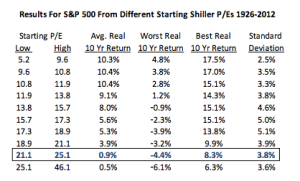If you look at the future returns, by valuation level, in the chart in yesterday’s post, you see that the higher the initial price, the lower the future returns. This makes sense both theoretically and empirically, but it creates a problem for investors right now, in that their expectations are totally out of line with what has happened in the past. While investors often expect miracles, many investors today are essentially relying on one—and have no idea that is the case.
The problem isn’t limited to stocks, either. For bonds, assuming interest rates remain the same, returns are the coupon payments—and then you get your money back. Your real return is coupon less inflation, which means on a par, on a real basis, with what stocks are likely to return on average. If rates rise, on the other hand, you could face capital losses, which would further erode returns. The only scenario in which bonds might make up for lower stock returns is if interest rates decline—and that’s very unlikely to happen on a consistent basis over the next decade. Anyone looking for higher returns won’t do it in bonds.












